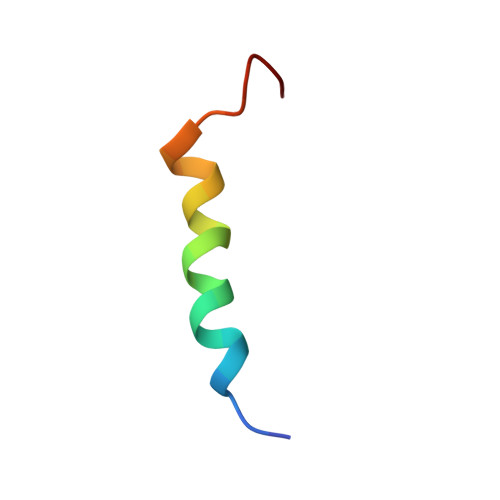Solution Structures of Human LL-37 Fragments and NMR-Based Identification of a Minimal Membrane-Targeting Antimicrobial and Anticancer Region.
Li, X., Li, Y., Han, H., Miller, D.W., Wang, G.(2006) J Am Chem Soc 128: 5776-5785
- PubMed: 16637646
- DOI: https://doi.org/10.1021/ja0584875
- Primary Citation of Related Structures:
2FBS, 2FBU, 2FCG - PubMed Abstract:
To understand the structure and activity relationship of human LL-37, a series of peptide fragments was designed. The N-terminal fragment, LL-37(1-12), was not active, while the C-terminal fragment, LL-37(13-37), killed Escherichia coli, as well as drug-sensitive and drug-resistant cancer cells. A 13-residue core antibacterial and anticancer peptide, corresponding to residues 17-29 of LL-37, was identified based on total correlated spectroscopy by trimming nonessential regions (TOCSY-trim). Because LL-37 acts on bacterial membranes, three-dimensional structures of its fragments were determined in micelles by NMR, including structural refinement by natural abundance 15N and 13C chemical shifts. Aromatic-aromatic interactions in the N-terminal fragment were proposed to be essential for LL-37 aggregation. The LL-37 core peptide adopts a similar structure in the micelles of SDS or dioctanoyl phosphatidylglycerol. This structure is retained in the C-terminal fragment LL-37(13-37) and very likely in intact LL-37 based on peptide-aided signal assignments. The higher antibacterial activity of the LL-37 core peptide than aurein 1.2 was attributed to additional cationic residues. To achieve selective membrane targeting, D-amino acids were incorporated into LL-37(17-32). While the D-peptide showed similar antibacterial activity to the L-diastereomer, it lost toxicity to human cells. Structural analysis revealed hydrophobic defects in the new amphipathic structure of the D-peptide, leading to a much shorter retention time on a reversed-phase HPLC column. It is proposed that hydrophobic defects as a result of incoherent hydrophobic packing provide a structural basis for the improvement in cell selectivity of the LL-37 fragment.
Organizational Affiliation:
Eppley Institute for Research in Cancer and Allied Diseases, University of Nebraska Medical Center, 986805 Nebraska Medical Center, Omaha, Nebraska 68198-6805, USA.














